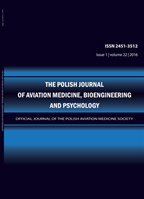2018, Volume 24, Issue 4
LOWER BODY NEGATIVE PRESSURE TRAINING LEADS TO LASTING REDUCTION IN CEREBRAL BLOOD FLOW: A PRELIMINARY STUDY USING ARTERIAL SPIN LABELING PERFUSION MRI
Stefan P. GAŹDZIŃSKI1, Krzysztof KOWALCZUK2, Piotr ZIELIŃSKI3, Paulina BARAN4, Mariusz KREJ4, Łukasz DZIUDA4
-------------------------------------------------------------------------------------------------
1Creative Neuroscience Lab – CNS Lab, Military Institute of Aviation Medicine
2Department of Simulator Studies and Aeromedical Training, Military Institute of Aviation Medicine
3Department of Aviation Psychology, Military Institute of Aviation Medicine
4Department of Flight Simulator Innovations, Military Institute of Aviation Medicine
Autor korenspondencyjny: Stefan P. GAŹDZIŃSKI; Creative Neuroscience Lab – CNS Lab, Military Institute of Aviation Medicine; email: stefan.gazdzinski@yahoo.com
Full text
Streszczenie
Introduction: Human Centrifuge and the Lower Body Negative Pressure (LBNP) test are both used to diagnose abnormalities in responses of the cerebrovascular system to hypergravity. Though both methods lead to net displacement of blood towards lower extremities, they elicit different hemodynamic responses, as human centrifuge training involves significantly more muscle work, resulting in more blood being diverted to muscles during the test. Centrifuge training is also known to result in a long-term improvement of the cerebrovascular function. Therefore, it is not clear if both training procedures have the same short- and long-term effects on the cerebrovascular function.
Methods: Eight military cadet pilots (23.8±0.8 years of age, one female) participated in the randomized, controlled, crossover study. To evaluate the differential effects of centrifuge training and LBNP on cerebral circulation post-training, we used pseudo-continuous arterial spin labeling (pCASL) 3T magnetic resonance imaging. The sequence was performed respectively before and after the LBNP training, as well as before and after the centrifuge training featuring equivalent protocols. The study was performed on two consecutive days. The values of mean CBF in gray matter were calculated and compared between conditions.
Results: Centrifuge training did not affect the CBF. However, a 4.95% (p=0.048) decrease in CBF was recorded after equivalent LBNP training. Moreover, in the five participants who underwent LBNP training on the first day, the CBF remained depressed at 10.1% (p=0.042), however, the inter-participant variability was large.
Conclusions: The results should be considered preliminary, as only a small cohort participated in this study. Further studies are needed to investigate more in-depth and in larger cohorts the short- and long-term cardiovascular effects of centrifuge and LBNP trainings.
Słowa kluczowe
MRI, arterial spin labeling, perfusion, cerebral blood flow, hypergravity, human centrifuge, lower body negative pressure (LBNP)
